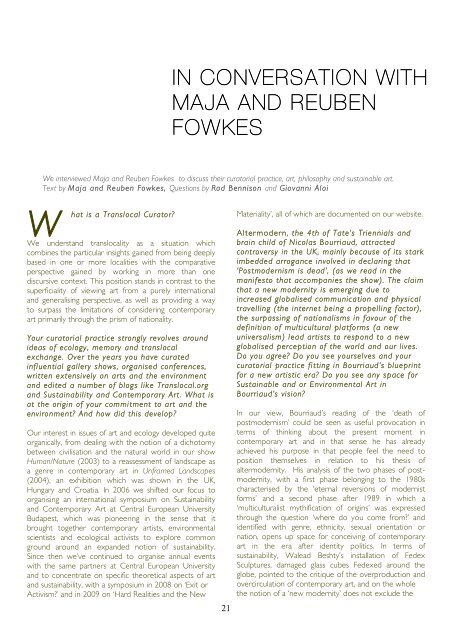M - Antennae The Journal of Nature in Visual Culture
M - Antennae The Journal of Nature in Visual Culture
M - Antennae The Journal of Nature in Visual Culture
You also want an ePaper? Increase the reach of your titles
YUMPU automatically turns print PDFs into web optimized ePapers that Google loves.
W<br />
hat is a Translocal Curator?<br />
We understand translocality as a situation which<br />
comb<strong>in</strong>es the particular <strong>in</strong>sights ga<strong>in</strong>ed from be<strong>in</strong>g deeply<br />
based <strong>in</strong> one or more localities with the comparative<br />
perspective ga<strong>in</strong>ed by work<strong>in</strong>g <strong>in</strong> more than one<br />
discursive context. This position stands <strong>in</strong> contrast to the<br />
superficiality <strong>of</strong> view<strong>in</strong>g art from a purely <strong>in</strong>ternational<br />
and generalis<strong>in</strong>g perspective, as well as provid<strong>in</strong>g a way<br />
to surpass the limitations <strong>of</strong> consider<strong>in</strong>g contemporary<br />
art primarily through the prism <strong>of</strong> nationality.<br />
Your curatorial practice strongly revolves around<br />
ideas <strong>of</strong> ecology, memory and translocal<br />
exchange. Over the years you have curated<br />
<strong>in</strong>fluential gallery shows, organised conferences,<br />
written extensively on arts and the environment<br />
and edited a number <strong>of</strong> blogs like Translocal.org<br />
and Susta<strong>in</strong>ability and Contemporary Art. What is<br />
at the orig<strong>in</strong> <strong>of</strong> your commitment to art and the<br />
environment? And how did this develop?<br />
Our <strong>in</strong>terest <strong>in</strong> issues <strong>of</strong> art and ecology developed quite<br />
organically, from deal<strong>in</strong>g with the notion <strong>of</strong> a dichotomy<br />
between civilisation and the natural world <strong>in</strong> our show<br />
Human/<strong>Nature</strong> (2003) to a reassessment <strong>of</strong> landscape as<br />
a genre <strong>in</strong> contemporary art <strong>in</strong> Unframed Landscapes<br />
(2004), an exhibition which was shown <strong>in</strong> the UK,<br />
Hungary and Croatia. In 2006 we shifted our focus to<br />
organis<strong>in</strong>g an <strong>in</strong>ternational symposium on Susta<strong>in</strong>ability<br />
and Contemporary Art at Central European University<br />
Budapest, which was pioneer<strong>in</strong>g <strong>in</strong> the sense that it<br />
brought together contemporary artists, environmental<br />
scientists and ecological activists to explore common<br />
ground around an expanded notion <strong>of</strong> susta<strong>in</strong>ability.<br />
S<strong>in</strong>ce then we’ve cont<strong>in</strong>ued to organise annual events<br />
with the same partners at Central European University<br />
and to concentrate on specific theoretical aspects <strong>of</strong> art<br />
and susta<strong>in</strong>ability, with a symposium <strong>in</strong> 2008 on ‘Exit or<br />
Activism?’ and <strong>in</strong> 2009 on ‘Hard Realities and the New<br />
IN CONVERSATION WITH<br />
MAJA AND REUBEN<br />
FOWKES<br />
We <strong>in</strong>terviewed Maja and Reuben Fowkes to discuss their curatorial practice, art, philosophy and susta<strong>in</strong>able art.<br />
Text by Maja and Reuben Fowkes, Questions by Rod Bennison and Giovanni Aloi<br />
21<br />
Materiality’, all <strong>of</strong> which are documented on our website.<br />
Altermodern, the 4th <strong>of</strong> Tate’s Triennials and<br />
bra<strong>in</strong> child <strong>of</strong> Nicolas Bourriaud, attracted<br />
controversy <strong>in</strong> the UK, ma<strong>in</strong>ly because <strong>of</strong> its stark<br />
imbedded arrogance <strong>in</strong>volved <strong>in</strong> declar<strong>in</strong>g that<br />
‘Postmodernism is dead’, (as we read <strong>in</strong> the<br />
manifesto that accompanies the show). <strong>The</strong> claim<br />
that a new modernity is emerg<strong>in</strong>g due to<br />
<strong>in</strong>creased globalised communication and physical<br />
travell<strong>in</strong>g (the <strong>in</strong>ternet be<strong>in</strong>g a propell<strong>in</strong>g factor),<br />
the surpass<strong>in</strong>g <strong>of</strong> nationalisms <strong>in</strong> favour <strong>of</strong> the<br />
def<strong>in</strong>ition <strong>of</strong> multicultural platforms (a new<br />
universalism) lead artists to respond to a new<br />
globalised perception <strong>of</strong> the world and our lives.<br />
Do you agree? Do you see yourselves and your<br />
curatorial practice fitt<strong>in</strong>g <strong>in</strong> Bourriaud’s bluepr<strong>in</strong>t<br />
for a new artistic era? Do you see any space for<br />
Susta<strong>in</strong>able and or Environmental Art <strong>in</strong><br />
Bourriaud’s vision?<br />
In our view, Bourriaud’s read<strong>in</strong>g <strong>of</strong> the ‘death <strong>of</strong><br />
postmodernism’ could be seen as useful provocation <strong>in</strong><br />
terms <strong>of</strong> th<strong>in</strong>k<strong>in</strong>g about the present moment <strong>in</strong><br />
contemporary art and <strong>in</strong> that sense he has already<br />
achieved his purpose <strong>in</strong> that people feel the need to<br />
position themselves <strong>in</strong> relation to his thesis <strong>of</strong><br />
altermodernity. His analysis <strong>of</strong> the two phases <strong>of</strong> postmodernity,<br />
with a first phase belong<strong>in</strong>g to the 1980s<br />
characterised by the ‘eternal reversions <strong>of</strong> modernist<br />
forms’ and a second phase after 1989 <strong>in</strong> which a<br />
‘multiculturalist mythification <strong>of</strong> orig<strong>in</strong>s’ was expressed<br />
through the question ‘where do you come from?’ and<br />
identified with genre, ethnicity, sexual orientation or<br />
nation, opens up space for conceiv<strong>in</strong>g <strong>of</strong> contemporary<br />
art <strong>in</strong> the era after identity politics. In terms <strong>of</strong><br />
susta<strong>in</strong>ability, Walead Beshty’s <strong>in</strong>stallation <strong>of</strong> Fedex<br />
Sculptures, damaged glass cubes Fedexed around the<br />
globe, po<strong>in</strong>ted to the critique <strong>of</strong> the overproduction and<br />
overcirculation <strong>of</strong> contemporary art, and on the whole<br />
the notion <strong>of</strong> a ‘new modernity’ does not exclude the












